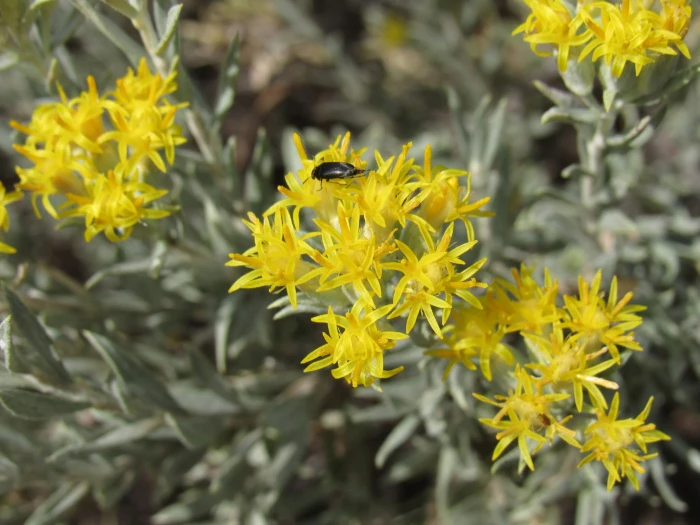Spineless Horsebrush
(Tetradymia canescens)
Spineless Horsebrush (Tetradymia canescens)
/
/

Anders Hastings
CC BY 4.0
Image By:
Anders Hastings
Recorded By:
Copyright:
CC BY 4.0
Copyright Notice:
Photo by: Anders Hastings | License Type: CC BY 4.0 | License URL: http://creativecommons.org/licenses/by/4.0/ | Rights Holder: Anders Hastings | Publisher: iNaturalist | Date Created: 2022-07-27T16:30:22-07:00 |

























Estimated Native Range
Climate Requirements for Memphis, Tennessee
| This Plant | Your Site | Plant Suitability for Your Location | ||
|---|---|---|---|---|
| • Precipitation | 5" - 105" | 53" | Aquatic | Aquatic |
| • High Temp. | 59°F - 102°F | 92°F | Your summer temperatures are normal for this plant. | Excellent |
| • Low Temp. | -7°F - 39°F | 30°F | Your winter temperatures are normal for this plant | Excellent |
This plant may not grow well at your location - your precipitation is too high.
Summary
Tetradymia canescens, commonly known as spineless horsebrush or gray horsebrush, is a perennial shrub native to the Great Basin and Mojave Desert regions, as well as sagebrush steppe and pinyon-juniper woodlands in western North America. It is found primarily east of the Cascade Range and Sierra Nevada, extending to Montana, Wyoming, Colorado, and New Mexico. Typically occurring at elevations of 4921-8858 feet, it thrives in well-drained, sandy or gravelly soils under full sun conditions. The shrub reaches a height of 4-31 inches and features multibranched stems covered with woolly fibers, along with narrow, lance-shaped leaves that contribute to its grayish appearance.
Spineless horsebrush blooms from May through October, producing clusters of pale to bright yellow flowers that are modest in size but can add a splash of color to arid landscapes. Its fire-resistant nature allows it to resprout vigorously after burns, making it valuable for revegetation and erosion control in fire-prone areas. While toxic to sheep, it has been utilized by Native American groups for various medicinal purposes. In cultivation, it is used primarily for xeriscaping and habitat restoration projects due to its drought tolerance and low maintenance requirements. However, gardeners should be aware of its toxicity to livestock and handle it with care if allergic reactions are a concern.CC BY-SA 4.0
Spineless horsebrush blooms from May through October, producing clusters of pale to bright yellow flowers that are modest in size but can add a splash of color to arid landscapes. Its fire-resistant nature allows it to resprout vigorously after burns, making it valuable for revegetation and erosion control in fire-prone areas. While toxic to sheep, it has been utilized by Native American groups for various medicinal purposes. In cultivation, it is used primarily for xeriscaping and habitat restoration projects due to its drought tolerance and low maintenance requirements. However, gardeners should be aware of its toxicity to livestock and handle it with care if allergic reactions are a concern.CC BY-SA 4.0
Plant Description
- Plant Type: Shrub
- Height: 2-4 feet
- Width: 2-3 feet
- Growth Rate: Slow
- Flower Color: Yellow
- Flowering Season: Spring, Summer, Fall
- Leaf Retention: Deciduous
Growth Requirements
- Sun: Full Sun, Part Shade
- Water: Low
- Drainage: Fast, Medium
Common Uses
Deer Resistant, Drought Tolerant, Erosion Control, Low Maintenance
Natural Habitat
Native to the Great Basin and Mojave Desert regions, sagebrush steppe, and pinyon-juniper woodlands
Other Names
Common Names: Common Horshbrush, Gray Horsebrush, Grey Horsebrush
Scientific Names: Tetradymia canescens, Tetradymia canescens var. inermis, Tetradymia canescens var. inermis, Tetradymia canescens var. linearis, Tetradymia canescens var. typica, Tetradymia inermis, Tetradymia linearis
GBIF Accepted Name: Tetradymia canescens